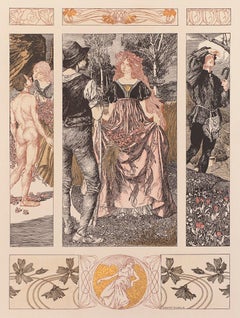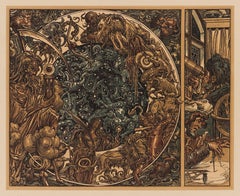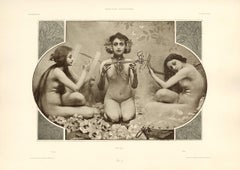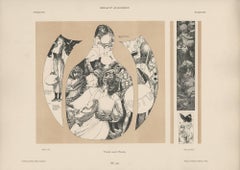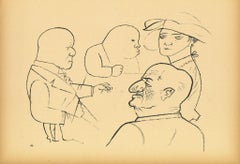Vienna Secession Prints and Multiples
to
26
16
10
26
Overall Height
to
Overall Width
to
4,374
443
150
63
35
21
15
12
11
2
1
26
18
17
12
10
10
9
4
3
3
2
1
1
1
1
1
1
26
155
2
67
22
34
32
10
9
3
1
25
1
Style: Vienna Secession
Period: 19th Century
Spring by Robert Engels, Medieval Art Nouveau lithograph with gold ink, 1897
Located in Chicago, IL
Allegorien-Neue Folge was a serialized folio published in installments between 1895 and 1900. Martin Gerlach, its publisher, was inspired by the rise of modernist design in Vienna an...
Category
1890s Vienna Secession Prints and Multiples
Materials
Lithograph
The Thirst, Plate 52 from Gerlach's Allegorien, Vienna Secession lithograph
Located in Chicago, IL
Wilhelm List, a friend and follower of Gustav Klimt, was a founder and leading member of the Vienna Secession and contributor to its official magazine, Ver Sacrum...
Category
1890s Vienna Secession Prints and Multiples
Materials
Lithograph
Astronomy, Plate 120 from Gerlach's Allegorien, Vienna Secession lithograph
By Hanus Schwaiger
Located in Chicago, IL
Allegorien-Neue Folge was a serialized publication of artworks by a group of Viennese artists and students beginning in 1897. Martin Gerlach, its publisher, was inspired by the new rise of modernist design in Vienna and selected those who were demonstrating a new command of the style to contribute works to the series, including Gustav Klimt, Koloman Moser, Carl Otto Czeschka, and Hanus Schwaiger. Each plate explores a different theme or collection of topics, such as dance, astronomy, electricity, and graphic arts, which brought a new aesthetic of design to the traditional allegory genre.
Stone lithograph of Hanus Schwaiger’s Astronomie, published as Plate 102 in Gerlach’s Allegorien...
Category
1890s Vienna Secession Prints and Multiples
Materials
Lithograph
Gerlach's Allegorien, plate #46: "Love" Lithograph, Gustav Klimt.
By Gustav Klimt
Located in Chicago, IL
Klimt’s association with Martin Gerlach dates back to the early 1880s when Gerlach and Schenk published their first edition of Allegorien und Embleme. By the mid-1890s, they were pla...
Category
1890s Vienna Secession Prints and Multiples
Materials
Lithograph
Gerlach's Allegorien Plate #37: "Music" Lithograph
Located in Chicago, IL
Koloman Moser
(1868 –1918), AUSTRIAN
Instead of applying his flair and art education solely to painting, Koloman Moser embodied the idea of Gesamt Kunstwerk (all-embracing art w...
Category
1890s Vienna Secession Prints and Multiples
Materials
Lithograph
Gerlach's Allegorien Plate #78: "Dance & Wine" Lithograph by Carl Otto Czeschka
Located in Chicago, IL
after Carl Otto Czeschka, (1878-1960), Austrian
A leading member of the Vienna Secession and later the Wiener Werkstätte (Viennese Workshop), Carl Otto Czeschka was a vital figu...
Category
1890s Vienna Secession Prints and Multiples
Materials
Lithograph
Gerlach's Allegorien Plate #75: "Hunting, Fishing, Rowing, Cycling"
Located in Chicago, IL
Koloman Moser
(1868 –1918), AUSTRIAN
Instead of applying his flair and art education solely to painting, Koloman Moser embodied the idea of Gesamt Kunstwerk (all-embracing art work) by designing architecture, furniture, jewelry, graphics, and tapestries meant to coordinate every detail of an environment. His work transcended the imitative decorative arts of earlier eras and helped to define Modernism for generations to come. Moser achieved a remarkable balance between intellectual structure (often geometric) and hedonistic luxury.
Collaborating with Gustav Klimt and Josef Hoffmann, the artist was an editor and active contributor to Ver Sacrum, (Sacred Spring), the journal of the Viennese Secession that was so prized for its aesthetics and high quality production that it was considered a work of art. The magazine featured drawings and designs in the Jugendstil style (Youth) along with literary contributions from distinguished writers from across Europe. It quickly disseminated both the spirit and the style of the Secession.
In 1903 Moser and Hoffmann founded and led the Wiener Werkstatte (Viennese Workshop) a collective of artisans that produced elegant decorative arts items, not as industrial prototypes but for the purpose of sale to the public. The plan, as idealistic then as now, was to elevate the lives of consumers by means of beautiful and useful interior surroundings.
Moser’s influence has endured throughout the century. His design sensibility is evident from the mid-century modern furniture of the 1950s and ‘60s to the psychedelic rock posters...
Category
1890s Vienna Secession Prints and Multiples
Materials
Lithograph
Gerlach's Allegorien Plate #20: "Song, Love, Music, Dance" Lithograph
Located in Chicago, IL
Koloman Moser
(1868 –1918), AUSTRIAN
Instead of applying his flair and art education solely to painting, Koloman Moser embodied the idea of Gesamt Kunstwerk (all-embracing art w...
Category
1890s Vienna Secession Prints and Multiples
Materials
Lithograph
Gerlach's Allegorien Plate #85: "Hunting" Lithograph by Carl Otto Czeschka
Located in Chicago, IL
after Carl Otto Czeschka, (1878-1960), Austrian
A leading member of the Vienna Secession and later the Wiener Werkstätte (Viennese Workshop), Carl Otto Czeschka was a vital figu...
Category
1890s Vienna Secession Prints and Multiples
Materials
Lithograph
Gerlach's Allegorien Plate #98: "Poetry" Lithograph by Carl Otto Czeschka
Located in Chicago, IL
after Carl Otto Czeschka, (1878-1960), Austrian
A leading member of the Vienna Secession and later the Wiener Werkstätte (Viennese Workshop), Carl Otto Czeschka was a vital figu...
Category
1890s Vienna Secession Prints and Multiples
Materials
Lithograph
Gerlach's Allegorien Plate #89: "Bookplate Spring" Lithograph
Located in Chicago, IL
Koloman Moser
(1868 –1918), AUSTRIAN
Instead of applying his flair and art education solely to painting, Koloman Moser embodied the idea of Gesamt Kunstwerk (all-embracing art work) by designing architecture, furniture, jewelry, graphics, and tapestries meant to coordinate every detail of an environment. His work transcended the imitative decorative arts of earlier eras and helped to define Modernism for generations to come. Moser achieved a remarkable balance between intellectual structure (often geometric) and hedonistic luxury.
Collaborating with Gustav Klimt and Josef Hoffmann, the artist was an editor and active contributor to Ver Sacrum, (Sacred Spring), the journal of the Viennese Secession that was so prized for its aesthetics and high quality production that it was considered a work of art. The magazine featured drawings and designs in the Jugendstil style (Youth) along with literary contributions from distinguished writers from across Europe. It quickly disseminated both the spirit and the style of the Secession.
In 1903 Moser and Hoffmann founded and led the Wiener Werkstatte (Viennese Workshop) a collective of artisans that produced elegant decorative arts items, not as industrial prototypes but for the purpose of sale to the public. The plan, as idealistic then as now, was to elevate the lives of consumers by means of beautiful and useful interior surroundings.
Moser’s influence has endured throughout the century. His design sensibility is evident from the mid-century modern furniture of the 1950s and ‘60s to the psychedelic rock posters...
Category
1890s Vienna Secession Prints and Multiples
Materials
Lithograph
Gerlach's Allegorien Plate #78: "Astronomy, The Creation, The Lie" Lithograph
Located in Chicago, IL
after Carl Otto Czeschka, (1878-1960), Austrian
A leading member of the Vienna Secession and later the Wiener Werkstätte (Viennese Workshop), Carl Otto Czeschka was a vital figu...
Category
1890s Vienna Secession Prints and Multiples
Materials
Lithograph
Gerlach's Allegorien Plate #93: "Science" Lithograph by Carl Otto Czeschka
Located in Chicago, IL
after Carl Otto Czeschka, (1878-1960), Austrian
A leading member of the Vienna Secession and later the Wiener Werkstätte (Viennese Workshop), Carl Otto Czeschka was a vital figu...
Category
1890s Vienna Secession Prints and Multiples
Materials
Lithograph
Gerlach's Allegorien Plate #114: "Vignettes" Lithograph by Carl Otto Czeschka
Located in Chicago, IL
after Carl Otto Czeschka, (1878-1960), Austrian
A leading member of the Vienna Secession and later the Wiener Werkstätte (Viennese Workshop), Carl Otto Czeschka was a vital figu...
Category
1890s Vienna Secession Prints and Multiples
Materials
Lithograph
Gerlach's Allegorien Plate #78: "Hunting" Lithograph by Carl Otto Czeschka
Located in Chicago, IL
after Carl Otto Czeschka, (1878-1960), Austrian
A leading member of the Vienna Secession and later the Wiener Werkstätte (Viennese Workshop), Carl Otto Czeschka was a vital figu...
Category
1890s Vienna Secession Prints and Multiples
Materials
Lithograph
Gerlach's Allegorien Plate #47: "Morning in the Spring" Lithograph
Located in Chicago, IL
Koloman Moser
(1868 –1918), AUSTRIAN
Instead of applying his flair and art education solely to painting, Koloman Moser embodied the idea of Gesamt Kunstwerk (all-embracing art work) by designing architecture, furniture, jewelry, graphics, and tapestries meant to coordinate every detail of an environment. His work transcended the imitative decorative arts of earlier eras and helped to define Modernism for generations to come. Moser achieved a remarkable balance between intellectual structure (often geometric) and hedonistic luxury.
Collaborating with Gustav Klimt and Josef Hoffmann, the artist was an editor and active contributor to Ver Sacrum, (Sacred Spring), the journal of the Viennese Secession that was so prized for its aesthetics and high quality production that it was considered a work of art. The magazine featured drawings and designs in the Jugendstil style (Youth) along with literary contributions from distinguished writers from across Europe. It quickly disseminated both the spirit and the style of the Secession.
In 1903 Moser and Hoffmann founded and led the Wiener Werkstatte (Viennese Workshop) a collective of artisans that produced elegant decorative arts items, not as industrial prototypes but for the purpose of sale to the public. The plan, as idealistic then as now, was to elevate the lives of consumers by means of beautiful and useful interior surroundings.
Moser’s influence has endured throughout the century. His design sensibility is evident from the mid-century modern furniture of the 1950s and ‘60s to the psychedelic rock posters...
Category
1890s Vienna Secession Prints and Multiples
Materials
Paper
Gerlach's Allegorien Folio, plate #58: "Sculpture" Lithograph, Gustav Klimt.
By Gustav Klimt
Located in Chicago, IL
As an artist trained in the applied arts, Gustav Klimt valued all forms of art, including the graphic arts. This final design from 1896 for inclusion in Allegorien published by Gerlach & Schenk demonstrates respect for artistic precedent and for a wide range of media and technique. The publication was printed in an unknown number of copies. Klimt’s rendering in latin of the title, “SCVLPTVR.,” with three-dimensional effect on the wall, is a figurative allusion to this medium as well as a literal reference to Ancient Rome. By doing the same with his signature and date in roman numerals on the right hand side of the image, Klimt places himself, The Artist, firmly in this linear and legitimizing context of art history and as its modern standard-bearer. Playing on Classical mythology and the story of Pygmalion, in which a statue comes to life, Klimt presents his modern Venus holding an apple. Klimt’s Venus exhibits a curvilinear softness; there are no angles. Klimt deftly shows the possibilities in a graphic image to give life to dark, wavy hair and tenderness to swelling breasts and belly. To further emphasize the allegory of thriving modern art, he contrasts his Venus with the cold, hard ancient classical head whose eyes are vacuous and whose hair is but a stylized mass of curls. Klimt’s living Venus stands in front of the large bust and large classical pillar upon which is a sculpture of a Sphinx and a Greek Attic bust. As if a gallery to represent sculpture’s “best of” through the ages, the upper horizontal panel includes bust depictions in marble, cast metal and wood...
Category
1890s Vienna Secession Prints and Multiples
Materials
Lithograph
Gerlach's Allegorien Plate #116: "Force, Thirst, Love" Lithograph
Located in Chicago, IL
after Carl Otto Czeschka, (1878-1960), Austrian
A leading member of the Vienna Secession and later the Wiener Werkstätte (Viennese Workshop), Carl Otto Czeschka was a vital figu...
Category
1890s Vienna Secession Prints and Multiples
Materials
Lithograph
Gerlach's Allegorien Plate #83: "Seasons" Lithograph by Carl Otto Czeschka
Located in Chicago, IL
after Carl Otto Czeschka, (1878-1960), Austrian
A leading member of the Vienna Secession and later the Wiener Werkstätte (Viennese Workshop), Carl Otto Czeschka was a vital f...
Category
1890s Vienna Secession Prints and Multiples
Materials
Lithograph
Gerlach's Allegorien Folio, plate #53: "Junius" Lithograph, Gustav Klimt.
By Gustav Klimt
Located in Chicago, IL
Contributors to Gerlach & Schenk’s publications valued design and innovation in the graphic arts just as much as they examined allegories as subject matter for exploration. Here, Gus...
Category
1890s Vienna Secession Prints and Multiples
Materials
Lithograph
Gerlach's Allegorien Plate #94: "Heads" Lithograph
Located in Chicago, IL
Koloman Moser
(1868 –1918), AUSTRIAN
Instead of applying his flair and art education solely to painting, Koloman Moser embodied the idea of Gesamt Kunstwerk (all-embracing art work) by designing architecture, furniture, jewelry, graphics, and tapestries meant to coordinate every detail of an environment. His work transcended the imitative decorative arts of earlier eras and helped to define Modernism for generations to come. Moser achieved a remarkable balance between intellectual structure (often geometric) and hedonistic luxury.
Collaborating with Gustav Klimt and Josef Hoffmann, the artist was an editor and active contributor to Ver Sacrum, (Sacred Spring), the journal of the Viennese Secession that was so prized for its aesthetics and high quality production that it was considered a work of art. The magazine featured drawings and designs in the Jugendstil style (Youth) along with literary contributions from distinguished writers from across Europe. It quickly disseminated both the spirit and the style of the Secession.
In 1903 Moser and Hoffmann founded and led the Wiener Werkstatte (Viennese Workshop) a collective of artisans that produced elegant decorative arts items, not as industrial prototypes but for the purpose of sale to the public. The plan, as idealistic then as now, was to elevate the lives of consumers by means of beautiful and useful interior surroundings.
Moser’s influence has endured throughout the century. His design sensibility is evident from the mid-century modern furniture of the 1950s and ‘60s to the psychedelic rock posters...
Category
1890s Vienna Secession Prints and Multiples
Materials
Lithograph
Gerlach's Allegorien Plate #51: "Summer" Lithograph
Located in Chicago, IL
Koloman Moser
(1868 –1918), AUSTRIAN
Instead of applying his flair and art education solely to painting, Koloman Moser embodied the idea of Gesamt Kunstwerk (all-embracing art w...
Category
1890s Vienna Secession Prints and Multiples
Materials
Lithograph
Gerlach's Allegorien Plate #44: "Music" Lithograph
Located in Chicago, IL
Koloman Moser
(1868 –1918), AUSTRIAN
Instead of applying his flair and art education solely to painting, Koloman Moser embodied the idea of Gesamt Kunstwerk (all-embracing art work) by designing architecture, furniture, jewelry, graphics, and tapestries meant to coordinate every detail of an environment. His work transcended the imitative decorative arts of earlier eras and helped to define Modernism for generations to come. Moser achieved a remarkable balance between intellectual structure (often geometric) and hedonistic luxury.
Collaborating with Gustav Klimt and Josef Hoffmann, the artist was an editor and active contributor to Ver Sacrum, (Sacred Spring), the journal of the Viennese Secession that was so prized for its aesthetics and high quality production that it was considered a work of art. The magazine featured drawings and designs in the Jugendstil style (Youth) along with literary contributions from distinguished writers from across Europe. It quickly disseminated both the spirit and the style of the Secession.
In 1903 Moser and Hoffmann founded and led the Wiener Werkstatte (Viennese Workshop) a collective of artisans that produced elegant decorative arts items, not as industrial prototypes but for the purpose of sale to the public. The plan, as idealistic then as now, was to elevate the lives of consumers by means of beautiful and useful interior surroundings.
Moser’s influence has endured throughout the century. His design sensibility is evident from the mid-century modern furniture of the 1950s and ‘60s to the psychedelic rock posters...
Category
1890s Vienna Secession Prints and Multiples
Materials
Lithograph
Gerlach's Allegorien Plate #35: "Love & Wine" Lithograph
Located in Chicago, IL
Koloman Moser
(1868 –1918), AUSTRIAN
Instead of applying his flair and art education solely to painting, Koloman Moser embodied the idea of Gesamt Kunstwerk (all-embracing art work) by designing architecture, furniture, jewelry, graphics, and tapestries meant to coordinate every detail of an environment. His work transcended the imitative decorative arts of earlier eras and helped to define Modernism for generations to come. Moser achieved a remarkable balance between intellectual structure (often geometric) and hedonistic luxury.
Collaborating with Gustav Klimt and Josef Hoffmann, the artist was an editor and active contributor to Ver Sacrum, (Sacred Spring), the journal of the Viennese Secession that was so prized for its aesthetics and high quality production that it was considered a work of art. The magazine featured drawings and designs in the Jugendstil style (Youth) along with literary contributions from distinguished writers from across Europe. It quickly disseminated both the spirit and the style of the Secession.
In 1903 Moser and Hoffmann founded and led the Wiener Werkstatte (Viennese Workshop) a collective of artisans that produced elegant decorative arts items, not as industrial prototypes but for the purpose of sale to the public. The plan, as idealistic then as now, was to elevate the lives of consumers by means of beautiful and useful interior surroundings.
Moser’s influence has endured throughout the century. His design sensibility is evident from the mid-century modern furniture of the 1950s and ‘60s to the psychedelic rock posters...
Category
1890s Vienna Secession Prints and Multiples
Materials
Lithograph
Gerlach's Allegorien Plate #30: "Love" Lithograph
Located in Chicago, IL
Koloman Moser
(1868 –1918), AUSTRIAN
Instead of applying his flair and art education solely to painting, Koloman Moser embodied the idea of Gesamt Kunstwerk (all-embracing art w...
Category
1890s Vienna Secession Prints and Multiples
Materials
Lithograph
Gerlach's Allegorien, plate #66: "Tragedy" Lithograph, Gustav Klimt.
By Gustav Klimt
Located in Chicago, IL
Gustav Klimt created this image for inclusion in Gerlach & Schenk’s Allegorien the year before he formed the Vienna Secession. While this design is similar to his other inclusions, L...
Category
1890s Vienna Secession Prints and Multiples
Materials
Lithograph
Related Items
Shark - Original Offset and Lithograph by George Grosz - 1923
By George Grosz
Located in Roma, IT
Shark is an original offset and lithograph, realized by George Grosz.
The artwork is the plate n. 66 from the porfolio Ecce Homo published between 1922/1923, edition of Der Malik-Ve...
Category
1920s Vienna Secession Prints and Multiples
Materials
Offset, Lithograph
H 9.65 in W 13.98 in D 0.04 in
Homeland Figures - Original Offset and Lithograph by George Grosz - 1923
By George Grosz
Located in Roma, IT
Homeland figures from Ecce Homo is an original offset and lithograph, realized by George Grosz in 1922.
The artwork is the plate n. 47 from the portfolio Ecce Homo published betwee...
Category
1920s Vienna Secession Prints and Multiples
Materials
Offset, Lithograph
H 13.98 in W 9.65 in D 0.04 in
Original Vintage Secession Poster celebrating the emperor's jubilee
Located in Zurich, CH
Original Vintage Poster by the Austrian artist Ferdinand Ludwig Graf, a member of the Hagenbund. This Viennese artist association moved as soon a...
Category
Early 1900s Vienna Secession Prints and Multiples
Materials
Paper
Free Shipping
H 48.82 in W 36.42 in D 0.04 in
Ottokar Mascha Folio, plate 8: "Poster for the 1st Vienna Secession Exhibition"
By Gustav Klimt
Located in Chicago, IL
After GUSTAV KLIMT (1862-1918) THESEUS UND MINOTAURUS, 1898, final design submission for poster advertising the first exhibition of the Vienna Secession, (In Mascha, no. 8) As a cele...
Category
1910s Vienna Secession Prints and Multiples
Materials
Lithograph
Jazzy
Located in London, GB
artist: Anastasia Kurakina
title: “Jazzy”
original art print on canvas
limited edition,
hand signed
size: 40x60cm
Anastasia Kurakina is an internationally renowned visual artist. To...
Category
2010s Vienna Secession Prints and Multiples
Materials
Color, Digital, Canvas
The Drunkard in Spring —after Gustav Mahler's 'The Song of the Earth'
Located in Myrtle Beach, SC
Arthur Paunzen, 'Der Trunkene im Frühling' (The Drunkard in Spring) from the suite 'Song of the Earth', etching, aquatint, and drypoint, 1920. Signed and titled in pencil. Signed in the plate, lower right. A fine, richly-inked impression, on cream, wove Japan paper; the full sheet with margins (2 1/4 to 4 1/4 inches), in good condition. Image size 12 3/8 x 9 1/8 inches; sheet size 19 5/8 x 13 5/8 inches. Matted to museum standards, unframed.
ABOUT THIS WORK
Pauzen’s suite of six etchings 'Das Lied von der Erde' (The Song of the Earth), published in 1920, was inspired by Gustav Mahler...
Category
1920s Vienna Secession Prints and Multiples
Materials
Etching, Drypoint, Aquatint
Execution - Offset and Lithograph by George Grosz - 1923
By George Grosz
Located in Roma, IT
Execution from Ecce Homo is an original offset and lithograph, realized by George Grosz.
The artwork is the plate n. 84 from the portfolio Ecce Homo published between 1922/1923, edi...
Category
1920s Vienna Secession Prints and Multiples
Materials
Lithograph, Offset
H 13.98 in W 9.65 in D 0.04 in
Of Youth —after Gustav Mahler's 'The Song of the Earth'
Located in Myrtle Beach, SC
Arthur Paunzen, 'Von der Jugend' (Of Youth) from the suite 'Song of the Earth', etching, aquatint, and drypoint, 1920. Signed and titled in pencil. Signed in the plate, lower left. A fine, richly-inked impression, on cream, wove Japan paper; the full sheet with margins (2 1/4 to 4 1/4 inches), in good condition. Image size 12 1/4 x 9 1/16 inches; sheet size 19 3/4 x 13 5/8 inches. Matted to museum standards, unframed.
ABOUT THIS WORK
Pauzen’s suite of six etchings 'Das Lied von der Erde' (The Song of the Earth), published in 1920, was inspired by Gustav Mahler...
Category
1920s Vienna Secession Prints and Multiples
Materials
Etching, Drypoint, Aquatint
The Solitary One in Autumn—after Gustav Mahler's 'The Song of the Earth'
Located in Myrtle Beach, SC
Arthur Paunzen, 'Der Einsame im Herbst' (The Solitary One in Autumn) from the suite 'Song of the Earth', etching, aquatint, and drypoint, 1920. Signed and titled in pencil. Signed in the plate, lower left. A fine, richly-inked impression, on cream, wove Japan paper; the full sheet with margins (2 3/8 to 4 1/8 inches), in good condition. Image size 12 3/8 x 8 7/8 inches; sheet size 19 5/8 x 13 3/4 inches. Matted to museum standards, unframed.
ABOUT THIS WORK
Pauzen’s suite of six etchings 'Das Lied von der Erde' (The Song of the Earth), published in 1920, was inspired by Gustav Mahler...
Category
1920s Vienna Secession Prints and Multiples
Materials
Etching, Drypoint, Aquatint
Fruhling
By Josef Siccard-Redl
Located in New York, NY
Siccard-Redl, Josef. Fruhling, Ca 1910. Color wood engraving, Signed and titled in pencil by the artist.
Little is known of this artist other than he worked in Vienna during the
...
Category
1910s Vienna Secession Prints and Multiples
Materials
Engraving
Ottokar Mascha Folio, plate 18: "Shaw Oder Die Ironie Poster" by Egon Schiele
By Egon Schiele
Located in Chicago, IL
after EGON SCHIELE (1890-1918) SHAW ODER DIE IRONIE POSTER, C. 1912, (In Mascha, no. 18) Schiele’s poster is an advertisement for a lecture to be given ...
Category
1910s Vienna Secession Prints and Multiples
Materials
Lithograph
The Factory - Lithograph and Offset by George Grosz - 1925
By George Grosz
Located in Roma, IT
The factoryis an original offset and lithograph realized by George Grosz.
The artwork is from the book Kobes by Heinrich Man, that was illustrated by Grosz with 10 lithographs and ...
Category
1920s Vienna Secession Prints and Multiples
Materials
Offset, Lithograph
H 10.83 in W 8.67 in D 0.04 in
Vienna Secession prints and multiples for sale on 1stDibs.
Find a wide variety of authentic Vienna Secession prints and multiples available for sale on 1stDibs. Works in this style were very popular during the 21st Century and Contemporary, but contemporary artists have continued to produce works inspired by this movement. If you’re looking to add prints and multiples created in this style to introduce contrast in an otherwise neutral space in your home, the works available on 1stDibs include elements of orange and other colors. Many Pop art paintings were created by popular artists on 1stDibs, including Gustav Klimt & K.K. Hof-und Staatsdruckerei, (after) Gustav Klimt, (after) Egon Schiele, and Gustav Klimt. Frequently made by artists working with Paper, and Lithograph and other materials, all of these pieces for sale are unique and have attracted attention over the years. Not every interior allows for large Vienna Secession prints and multiples, so small editions measuring 3 inches across are also available. Prices for prints and multiples made by famous or emerging artists can differ depending on medium, time period and other attributes. On 1stDibs, the price for these items starts at $250 and tops out at $125,000, while the average work sells for $3,500.
Recently Viewed
View AllMore Ways To Browse
Black Mickey
Air France Travel Poster
Tapestry Children
Hat Women Fashion
Robert Michel
British World War 1
Old Vintage Planes
Old Vintage Plane
Homage To Picasso
Hunting Scene Prints
Scotland Posters
Acid Green Painting
1980s Punk
Map Of South Of France
Tate Posters
Century Sculpture Black Couple
Retro Dancing Flower
Winter Sports Art
